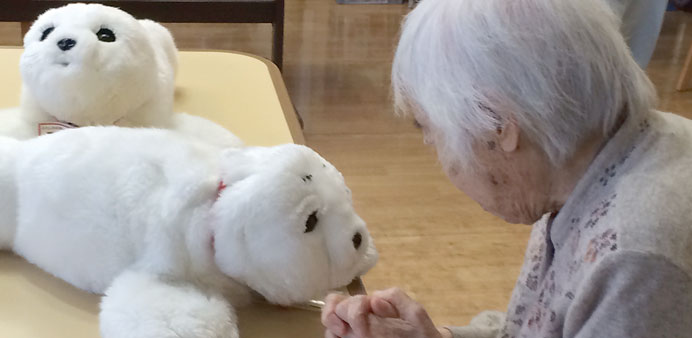Japanese society is ageing rapidly, and one of the consequences is the expectation that there will be a lack of care workers, rising to almost half a million by 2020, writes Lars Nicolaysen
Parlo raises his arms in the air to the sound of music, then calls out in a child’s voice: “Let’s clap in time.”
A dozen elderly Japanese in the community room of the Fuyo-En rest home in Yokohama near Tokyo watch the little robot standing on the table in front of them in bemusement.
They have not all been able to understand what the 40-centimetre humanoid robot said. A care worker in a white apron walks up to the robot and repeats his encouragement, and as Parlo begins to dance, one of the elderly ladies calls out: “Yes, yes.”
“The robot has become part of our daily life’” says Akira Kobayashi, the director of the care home, which lies in a special economic zone for promoting robots set up in Kanagawa Province.
“Parlo is perceived by some of our ladies as a small child,” Kobayashi says, as the robot plays guessing games with the elderly people.
“The robot has more than 365 different programs. We use it to improve the mood in our daily relaxation sessions with the residents.”
Parlo was developed by the Fuji Soft company.
“The robot’s aim is to create a new relationship between people and computers,” says Eiji Honda, head of the Japanese company’s robot division.
He notes that computers have to date largely been tools. “We want to make partners of them,” Honda says, pointing to a poster in his office of Astro Boy, a comic figure known in Japan as Tetsuwan Atomu and originally drawn by Osamu Tezuka.
The manga comic of the 1950s and 1960s about a boy android with supernatural powers is in a sense a forerunner of Parlo. It’s also an indicator of Japan’s enthusiasm for cutting-edge technology that goes back several generations, along with acceptance of all kinds of robots.
Parlo is equipped with artificial intelligence (AI) and is able to recognise people by their voices and respond to them. His arms and legs recall larger androids, such as Honda’s ASIMO and Sony’s AIBO robot dog.
Both created a stir several years ago and established Japan’s reputation as the world’s leading robot nation.
Japanese industry and researchers are not interested in robots for their entertainment value alone. Robots for services are the focus, particularly care robots, on which industry and the state are co-operating closely.
Japanese society is ageing rapidly, and one of the consequences is the expectation that there will be a lack of care workers, rising to almost half a million by 2020.
Toyota Motor has, for example, developed a “care assist robot” to help bed-ridden patients get out of bed, for example to go to the toilet.
Panasonic has now developed a bed, part of which can be turned into a wheelchair. The electronics giant is also working on a series of robot suits, like the battery-powered Ninja model, that will help someone to carry heavy objects or even another person.
“Special sensors measure precisely how much strength is needed,” Panasonic spokesperson Yayoi Watanabe says.
The idea is not for robots to replace care workers, but rather for them to assist their human colleagues as helpers.
“To be honest, you can also manage without a robot like Parlo,” Kobayashi says, adding that Parlo is simply another tool for stimulating the elderly to communicate or to enjoy their meals more.
The situation is similar with the robot seal Paro, which is also used at the Fuyo-En care home. Although simply a machine disguised as a cuddly seal in white fur, Paro is able to assist the care workers look after withdrawn patients suffering from depression and dementia.
“For example, it happens that when a patient has been brought into the dining hall and sits down, they forget within a couple of minutes what they are there for and become anxious,” Kobayashi says.
“Before we introduced the robots, a care worker had been needed to deal with this situation,” he says, but now the patient can engage with the seal, frequently leading to a more cheerful atmosphere and easing the task of the care workers.
This is a key issue in robot development, as care workers face an arduous task, both physically and psychologically.
Robots are there to ease the load and to prevent skilled care home staff giving up the job in frustration and also to convince young people to embark on a career as carer.
“Industrial robots are there to replace factory workers and to raise productivity. But in the care sector, people play the main role, and the robots support them. They live and work along side each other,” says Shiro Sekiguchi, who works for an organisation promoting the use of care robots in Yokohama.
“We will not have the situation where robots take over the primary care for people,” he says.
There are still difficulties facing the Japanese in introducing service and care robots on a wide scale. According to economic research institute Yano, the market for care robots in fiscal 2012-13 was a little more than 1 billion yen (US$10 million).
The relatively limited market is attributed at least partly to the high development costs, as well as the lack of functionality in the robots. The care sector poses complex problems for the developers, meaning they are soon at the limits of their technical capabilities.
While Japan already has a large range of robots and related technologies, by no means all these products achieve market success.
Many are at best prototypes under development. Many believe that deregulation of the care sector would boost robot development.
Prime Minister Shinzo Abe has shown enthusiasm for robot technology. During a recent visit to a rest home in Saitama near Tokyo, where he tried out a robot bed, Abe said: “I would like to make robots a pillar of my growth strategy.”
The aim is to treble the robot market, which currently totals 2.4 trillion yen annually.

UP, CLOSE AND PERSONAL: A resident of the Fuyo-En rest home in Yokohama takes a closer look at Paro, a robot in the form of a toy white seal.


